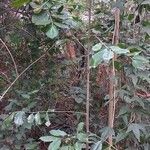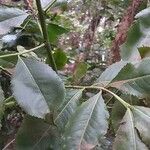Evergreen shrubs, 1-5 m tall; young branches with white, fine lenticels. Petiole 3-8 mm; leaf blade elliptic or narrowly elliptic, 4-7 × 2-4 cm, leathery, base narrowly attenuate, slightly decurrent, margin obtusely serrate, apex obtusely shortly acuminate. Cymes single, small, 1.5-2 × as wide; peduncle 5-10 mm, 2-4-branched, branches short, less than 3 mm; pedicel 1-3 mm, up to 5 mm in fruit. Flowers 3-5 mm in diam.; sepals 5, triangular-ovate, ca. 1 mm; petals 5, white, narrowly ovate or narrowly oblong. Stamens 5, filamentous, shorter than corolla. Ovary free, surrounded by disk; stigma 3-lobed. Capsule orange-red, cylindric, ca. 8 × 3-4 mm, dehiscing from above, loculicidally in 3 valves, usually only 1 seed maturing per valve. Seeds black-brown, narrowly ovoid, 3-4 mm, with membranous basal wing.
A shrub or small evergreen tree. It grows to 7-18 m high and spreads 3 m across. Trees that are regularly harvested are smaller. The stem is erect. The bark is grey and smooth when young. It becomes dark brown and flaky at maturity. The branches hang downwards. The leaves are simple and opposite. The leaves are glossy green and oval. They are 5-11 cm long and the edges of the leaf have small teeth. Leaves are paler underneath. The leaf stalks are reddish and about 1 cm long. The flowers are very small and pale green to white and with 5 petals. They occur in small clusters in the axils of leaves. The clusters are up to 2 cm across. The fruit has 3 lobes. It is a woody capsule about 1 cm long. It is reddish brown when mature. It contains many small winged seeds.
Evergreen tree, up to 15 m high. Branchlets with waxy bloom, flattened, becoming vinous red or pinkish and terete. Leaves subleathery; lamina oblong, elliptic or obovate, 30-50(-110) x 8-45(-60) mm, apex obtuse, acute to acuminate, base cuneate to angustate, margins glandular-toothed; dense reticulate venation more prominent below than above; petioles 3-10 mm long. Inflorescences axillary cymes. Flowers 5-merous, greenish white; peduncle 6-12 mm long. Sepals broadly ovate, ± 0.5 mm long, margins ciliate-fimbriate. Petals elliptic-oblong, 1-2 mm long, margins ciliolate. Ovary broadly ovoid; style short. Fruit a 3-valved capsule, narrowly oblong-trigonous, 6-10 mm long, smooth, reddish to brown. Seeds with basal wing, exarillate.
Leaves with lamina dark green or greyish-green and glossy above, paler beneath, (3·7)5·5–11 × (0·8)1·5–4·5(6) cm., oblong to elliptic or obovate, acute to acuminate or more rarely obtuse at the apex, with margin markedly glandular-crenulate-denticulate, cuneate to angustate at the base, coriaceous or subcoriaceous, with densely reticulate venation more prominent below than above; petiole 3–10 mm. long; stipules c. 2 mm. long, triangular-acicular.
Evergreen tree, up to 25 m high. Leaves opposite, lamina ovate-lanceolate to elliptic, 50-100 x 15-30 mm, venation prominent, margin serrate. Seed with white, wing-like aril.
Petals 1–1·5 mm. long, elliptic-oblong, with margin ciliolate and paler in colour (at least when dry).
Tree 2–15(25) m. high; stems pale grey-green and flattened when young, becoming vinous red, terete.
Sepals 0·5–0·7 mm. long, broadly ovate to semicircular, rounded, with margin ciliate-fimbriate.
Flowers ?; peduncle 6–12 mm. long; bracts 0·5–1 mm. long, acicular to triangular.
Capsule red, 6–10 mm. long, narrowly oblong-3-gonous, pendulous.
Seeds rugose-papillose, with a basal wing.
Ovary broadly ovoid; styles short.



